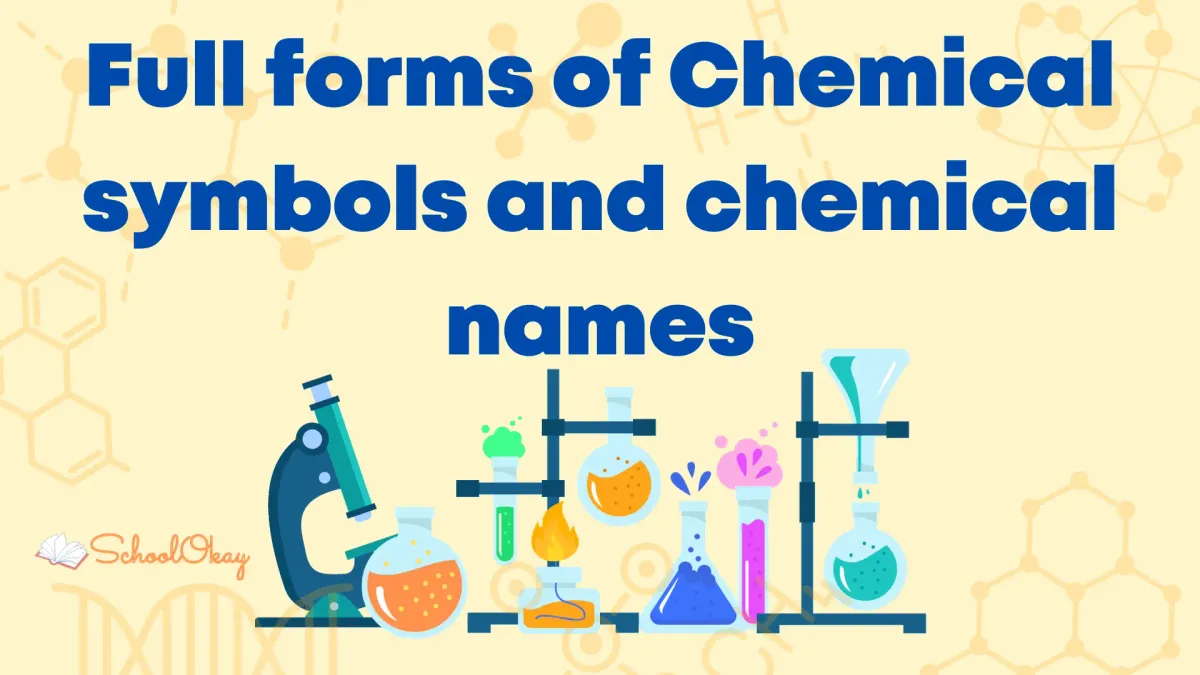Full Forms of Chemical Symbols: The Alphabet of Chemistry
Chemistry is the language of elements, and chemical symbols serve as its alphabet. These symbols, consisting of one or two letters, simplify

Chemistry is the language of elements, and chemical symbols serve as its alphabet. These symbols, consisting of one or two letters, simplify the notation of chemical elements, compounds, and reactions. Typically derived from the element's name in English or another language (e.g., Latin or Greek), they are essential for writing chemical formulas, equations, and other notations in chemistry. This guide provides a comprehensive list of chemical symbols for elements from atomic number 1 (Hydrogen) to 118 (Oganesson), along with their significance and related resources.
What Are Chemical Symbols?
Chemical symbols are shorthand representations of chemical elements, enabling scientists and students to efficiently document and communicate complex chemical processes. For example, instead of writing "Hydrogen," the symbol H is used. These symbols are universally recognized and form the foundation of chemical notation, making it easier to understand reactions and compounds.
List of Chemical Symbols
Below is the complete list of chemical symbols for all known elements in the periodic table, ordered by atomic number:
- H - Hydrogen
- He - Helium
- Li - Lithium
- Be - Beryllium
- B - Boron
- C - Carbon
- N - Nitrogen
- O - Oxygen
- F - Fluorine
- Ne - Neon
- Na - Sodium
- Mg - Magnesium
- Al - Aluminum
- Si - Silicon
- P - Phosphorus
- S - Sulfur
- Cl - Chlorine
- Ar - Argon
- K - Potassium
- Ca - Calcium
- Sc - Scandium
- Ti - Titanium
- V - Vanadium
- Cr - Chromium
- Mn - Manganese
- Fe - Iron
- Co - Cobalt
- Ni - Nickel
- Cu - Copper
- Zn - Zinc
- Ga - Gallium
- Ge - Germanium
- As - Arsenic
- Se - Selenium
- Br - Bromine
- Kr - Krypton
- Rb - Rubidium
- Sr - Strontium
- Y - Yttrium
- Zr - Zirconium
- Nb - Niobium
- Mo - Molybdenum
- Tc - Technetium
- Ru - Ruthenium
- Rh - Rhodium
- Pd - Palladium
- Ag - Silver
- Cd - Cadmium
- In - Indium
- Sn - Tin
- Sb - Antimony
- Te - Tellurium
- I - Iodine
- Xe - Xenon
- Cs - Cesium
- Ba - Barium
- La - Lanthanum
- Ce - Cerium
- Pr - Praseodymium
- Nd - Neodymium
- Pm - Promethium
- Sm - Samarium
- Eu - Europium
- Gd - Gadolinium
- Tb - Terbium
- Dy - Dysprosium
- Ho - Holmium
- Er - Erbium
- Tm - Thulium
- Yb - Ytterbium
- Lu - Lutetium
- Hf - Hafnium
- Ta - Tantalum
- W - Tungsten
- Re - Rhenium
- Os - Osmium
- Ir - Iridium
- Pt - Platinum
- Au - Gold
- Hg - Mercury
- Tl - Thallium
- Pb - Lead
- Bi - Bismuth
- Po - Polonium
- At - Astatine
- Rn - Radon
- Fr - Francium
- Ra - Radium
- Ac - Actinium
- Th - Thorium
- Pa - Protactinium
- U - Uranium
- Np - Neptunium
- Pu - Plutonium
- Am - Americium
- Cm - Curium
- Bk - Berkelium
- Cf - Californium
- Es - Einsteinium
- Fm - Fermium
- Md - Mendelevium
- No - Nobelium
- Lr - Lawrencium
- Rf - Rutherfordium
- Db - Dubnium
- Sg - Seaborgium
- Bh - Bohrium
- Hs - Hassium
- Mt - Meitnerium
- Ds - Darmstadtium
- Rg - Roentgenium
- Cn - Copernicium
- Nh - Nihonium
- Fl - Flerovium
- Mc - Moscovium
- Lv - Livermorium
- Ts - Tennessine
- Og - Oganesson
Importance of Chemical Symbols
Chemical symbols are critical for:
- Simplifying Notation: They condense complex element names into concise symbols, streamlining chemical equations and formulas.
- Universal Communication: Standardized symbols ensure that scientists worldwide can understand chemical information.
- Facilitating Learning: Students can more easily grasp chemical reactions and processes by using symbols instead of full element names.
For example, the chemical formula for water, H₂O, uses symbols to indicate two hydrogen atoms bonded to one oxygen atom, making it quick to write and understand.
Related Resources for Chemistry Students
To deepen your understanding of chemistry and excel in exams, explore these resources:
- Interactive Periodic Table - A dynamic tool from the Royal Society of Chemistry to explore elements, their symbols, and properties.
- Chemistry Study Guides - Khan Academy offers free tutorials on chemical symbols, reactions, and more.
- Sample Papers for ISC Class 12 Science - Access official ISC sample papers to practice chemistry questions, including those involving chemical symbols.
- Note-Making Tips for Students - Learn effective note-making strategies to organize chemistry concepts for better exam preparation.
- How to Crack Competitive Exams - BYJU’S provides tips for mastering subjects like chemistry in competitive exams.
Conclusion
Chemical symbols are the backbone of chemistry, enabling efficient representation of elements and compounds. By mastering these symbols, students and scientists can better understand and communicate chemical processes. Use the provided list and resources to enhance your chemistry knowledge and excel in your studies.
Subscribe to our blog for more educational content and share this guide with fellow chemistry enthusiasts!
Here are other articles you can read:



Share with others.







Comments ()